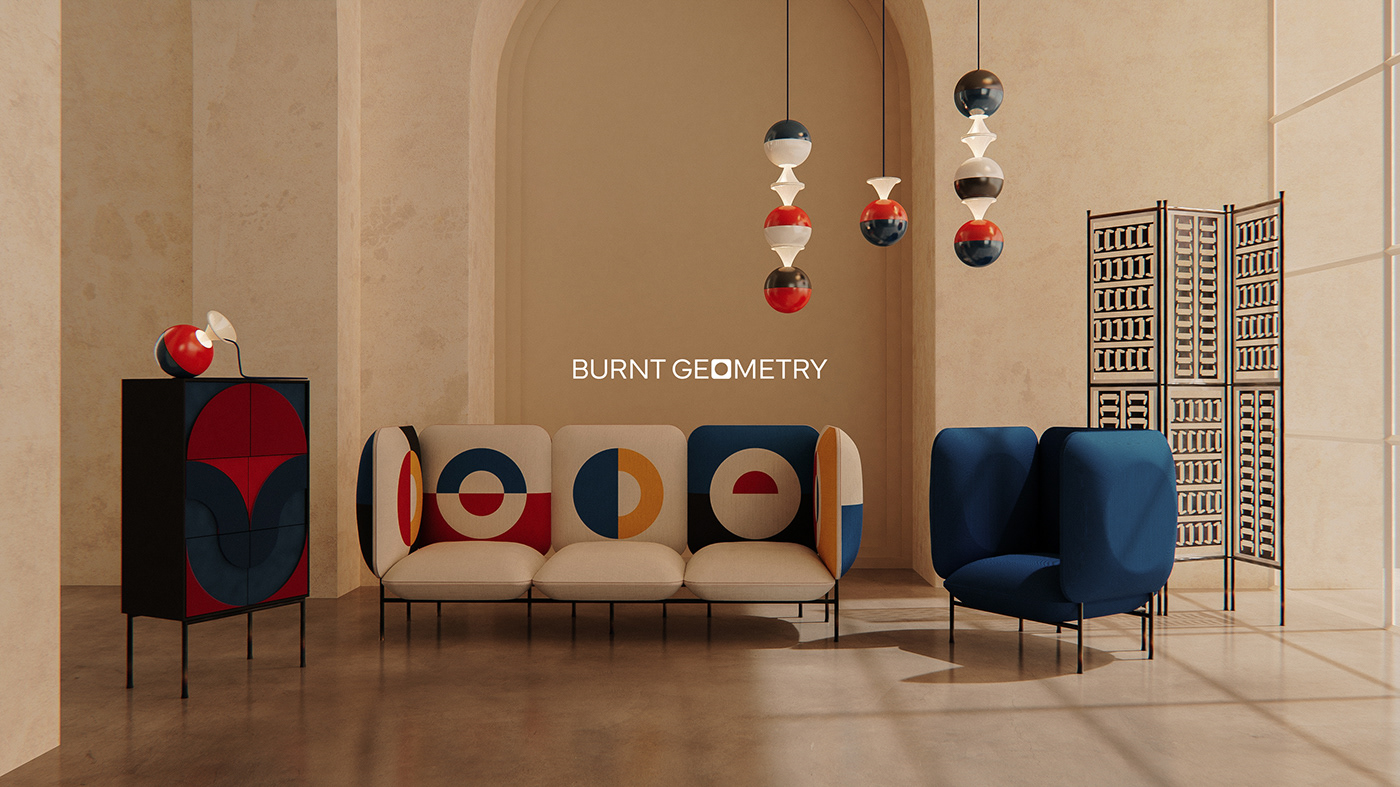
Logo design: Dare studio, render: own
Geometry, function and a tribute to old masters: the four product families of Burnt Geometry* were born at the crossroad of these factors.
Burnt Geometry was also created with the intention of contributing to the search for the paths of Hungarian design, relying on an internationally considerable tradition.
The products and furnitures form a bridge between contemporary trends and the excellence of Hungarian design and art history, thus the Bauhaus movement, Lajos Kassák, Victor Vasarely and Ferenc Lantos as well as the "Architectural Enamel Art Camp" in the Bonyhád Enamel Factory, of which he was a leading figure, are also among the forerunners.
The collection includes a family of seating furniture for public spaces called Dedas, a lamp named Roly-poly, a cabinet called Vanishing Cabinet, and a room divider called Dad’s fence.
The stand-alone microuniverses, designed as synergies, have a strong effect, almost defining the receiving space, but on the other hand, they fit in easily with any other element in the collection.
*Burnt Geometry is also the title of a publication and exhibition published in the care of the acb gallery about the "Architectural enamel art camp" in Bonyhád.
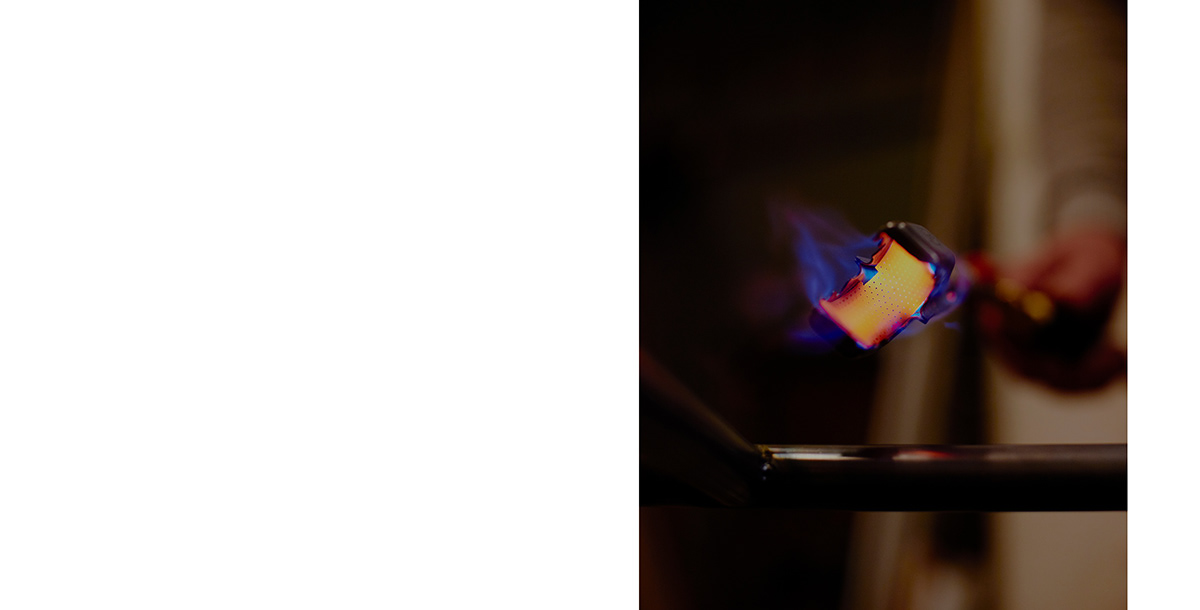
Photo: Anett Pósalaki
DEDAS
seating system

Render: own
INSPIRATIONS
The “Magna Mater” of the upholstered seating furniture collection for public spaces is the 3 seater sofa decorated with a uniquely designed pattern, for which the inspiring source was the enamel frieze works of a Hungarian artist, Ferenc Lantos.
The parallel can be found in the regular square backrest and seating element and the geometric editing of the unique pattern specifically designed for this sofa.
However, while Lantos used the circle arranged in a square and the diagonals (strings, rays) intersecting them to the create a hard, masculine pattern, in the case of the seating furniture the enclosing shape softens as the squares appear with rounded corners and the pattern set is completely feminised, partly because the use of the diagonal is completely vanished. Thus, the patterns of each field appear with different phase states of the circle, which can even be understood as analogies of the lunar phases.
Perhaps, the most spectacular feminization is in the spatialization of patterns. The original enamel frieze works are flat in nature due to the sheet metal substrates. In comparison, the lens-like rounding of the spherical surface of the foams and the section plane drawing an outline in its projection result in a vibrantly exciting visual experience. This look also endows the furniture with a strictly edited organicity. Just as Lantos reached for the well-known Bauhaus colours, the patterns from Dedas' 'leading ship’ use this spectrum of pure colours as well. The other members of the family are based on a rich colour palette in monochrome versions.

Photo: Artúr Ekler



Photo: Artúr Ekler
Description
The basic members of the Dedas family are the 1, 2 and 3 seater sofas, but the unique and special feature of the collection is that new functional elements are included in addition to these basic configurations.
An example of this is the higher backrest seating furniture intended for public or office use that provides the intimacy of telephony. The modular structure also holds the possibility to increase and classify the furniture, so it can be feasible on almost any scale. This is not only true laterally, because the seating surfaces can also be reflected on the other side of the back of the furniture, thus creating a spatial furniture island. This space-adjustability is a deliberately designed feature of all elements – the outer surface of the backrest and the system of filigree legs as distinctive features almost suggest/offer the possibility of the furniture playing a central role in public spaces. Dedas is a true “centrepiece”.
In addition to the rigourous design, playful, new features also appear in the Dedas family. If we imagine that in a configuration installed by a wall, the square raster of the backrests continues, the upholstered elements “climbed” on the wall will stand out as both a sound-absorbing surface and a decorative graphic pattern.
The relation between spatial form and the fabric is particularly important for Dedas. The fabric's hexagonal weaving structure has no primary (stated) direction, so it fits perfectly with the 3D curves of the furniture. In addition, this weaving structure is slightly flexible, so it is suitable for their seamless coating.
The colours of the fabrucs are intense, and the two- or three-colour fibre appears iridescent on these complex, rounded shapes, amplifying the sculpture and even shaping and changing it depending on the point of view– giving them an almost trompe-l'œil-like appearance, evoking a visual gesture that also regulates one of Victor Vasarely’s lines of research.
The patinated steel surface of the furniture legs directly reflect on the act of burning – referring to both the process of fire enamelling and the industrial environment. Formally, the protruding leg ends, which provide filigree, point-like support, are analogous to the supports (spikes) used in kilns, on which workpieces covered with “raw” enamel are placed.



Photo: Anett Pósalaki
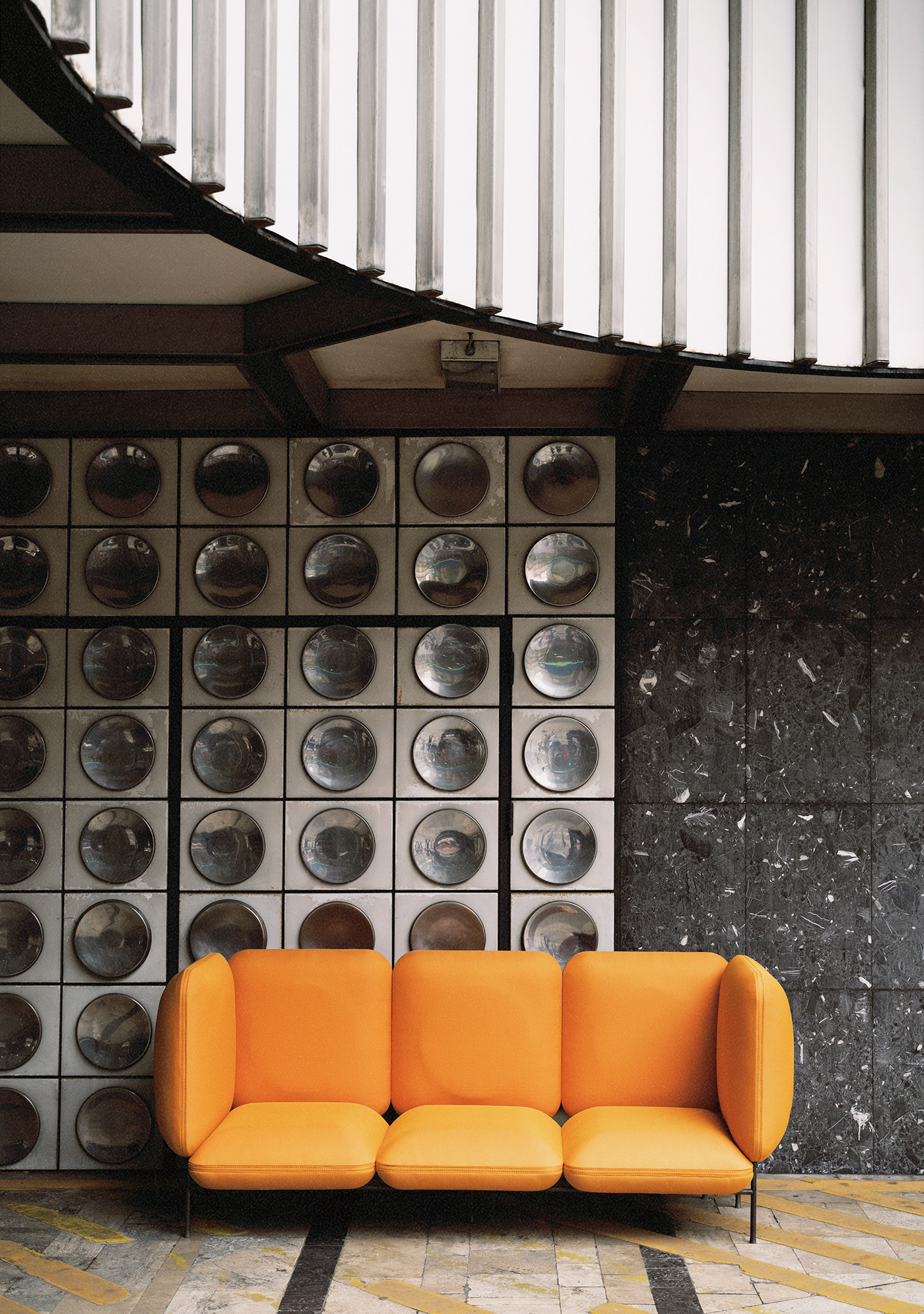
Photo: Artúr Ekler






Photo: Artúr Ekler


Photo: Artúr Ekler

Photo: Artúr Ekler
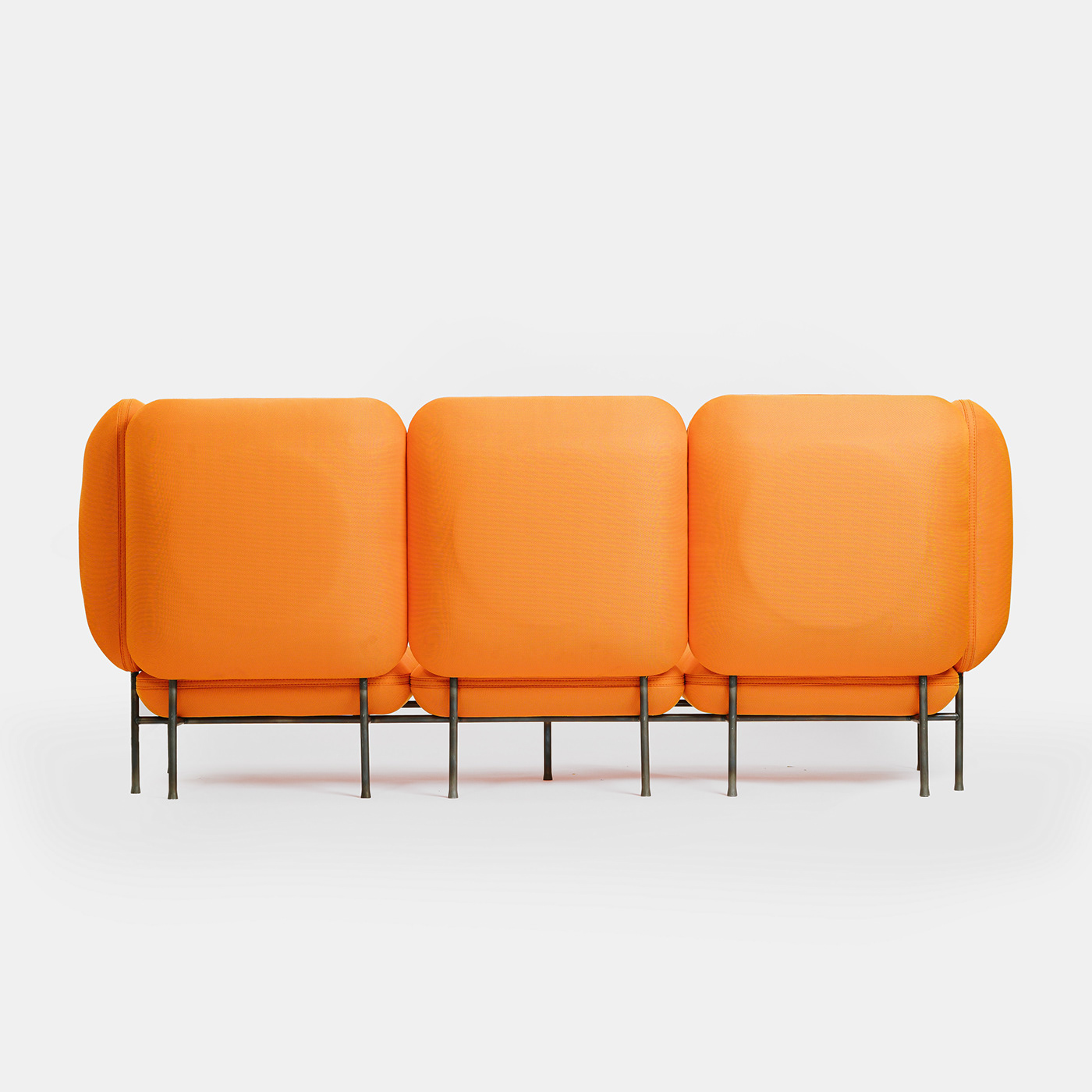
Photo: Milán Rácmolnár


Photo: Milán Rácmolnár
TECHNICAL DETAILS
Like all pieces of Burnt Geometry, Dedas were made by Hungarian implementers and manufacturers. The use of local infrastructure was an important consideration in the definition of both technologies and materials – with the exception of the fabric.
The seating furniture was realised during the Design LAB incubation program of the Hungarian Fashion & Design Agency in cooperation with the upholstery firm Kárpitos Partner Group.
The patterned fabricu was made with printing equipment, the contractor was NUANS Textil Kft. The monochrome versions are coated with CLIMATEX® fabrics supplied by the Hungarian representative of the German JAB Joseph Anstoetz KG. CLIMATEX® fabrics are among the few in the textile industry that have the “C to C - Cradle to Cradle” trademark, meaning that the product is 100% recyclable, the fabric can be broken down into raw materials after the expiration of the products lifecycle . These fabrics are otherwise flame retardant and have a wear resistance value of 450,000 martindales, allowing for long-term use in public spaces as well.
The structural designs incorporate a number of professional upholstery feats in line with the designer’s intentions. The foam structure, for example, is cut and unmoulded, yet can result in spatial curved surfaces. Thus, even with small series production capacity, their production remains economical, as there is no need to make expensive casting tools. And if now, at the beginning of the development phase, the geometry or composition of the foams need changes for some reason, those can be accomplished with a minimal investment with a cut foam. The weaving structure of the fabric prevents the accumulation of excess material at the edges of the backrests, even at arches with a smaller radius.This eliminates the need for visible seams. The outer and inner backrest elements can be fitted together just as lego-bricks. The way they are attached to each other, and therefore their structural function, is the result of a unique innovation. Partly, this allows the elements to be replaced with minimal intervention in an event of damage. Here, in the gap between the double-sided backrest modules, is the first successful application of EVA foam in the upholstery industry, as an alternative to traditional welting.
The support of the furniture is a frame structure made of precision tubes, and the patination of the surfaces is entirely performed by IO. The long-term development goal is that the acrylic lacquer protection against the corrosion of the metal frame structure will be replaced by natural surface sealing, such as beeswax.
These features, such as the longer product lifecycle due to high quality, the use of recyclable CLIMATEX® fabric, the use of a steel structure, the heterogeneous (recycled) foam used in the foam layer, the discreet surface treatment technology, or the ease of repair, are all results of purely conscious design decisions that was aimed to result in a family of furniture that is also exemplary in terms of sustainability, renewability and recyclability.
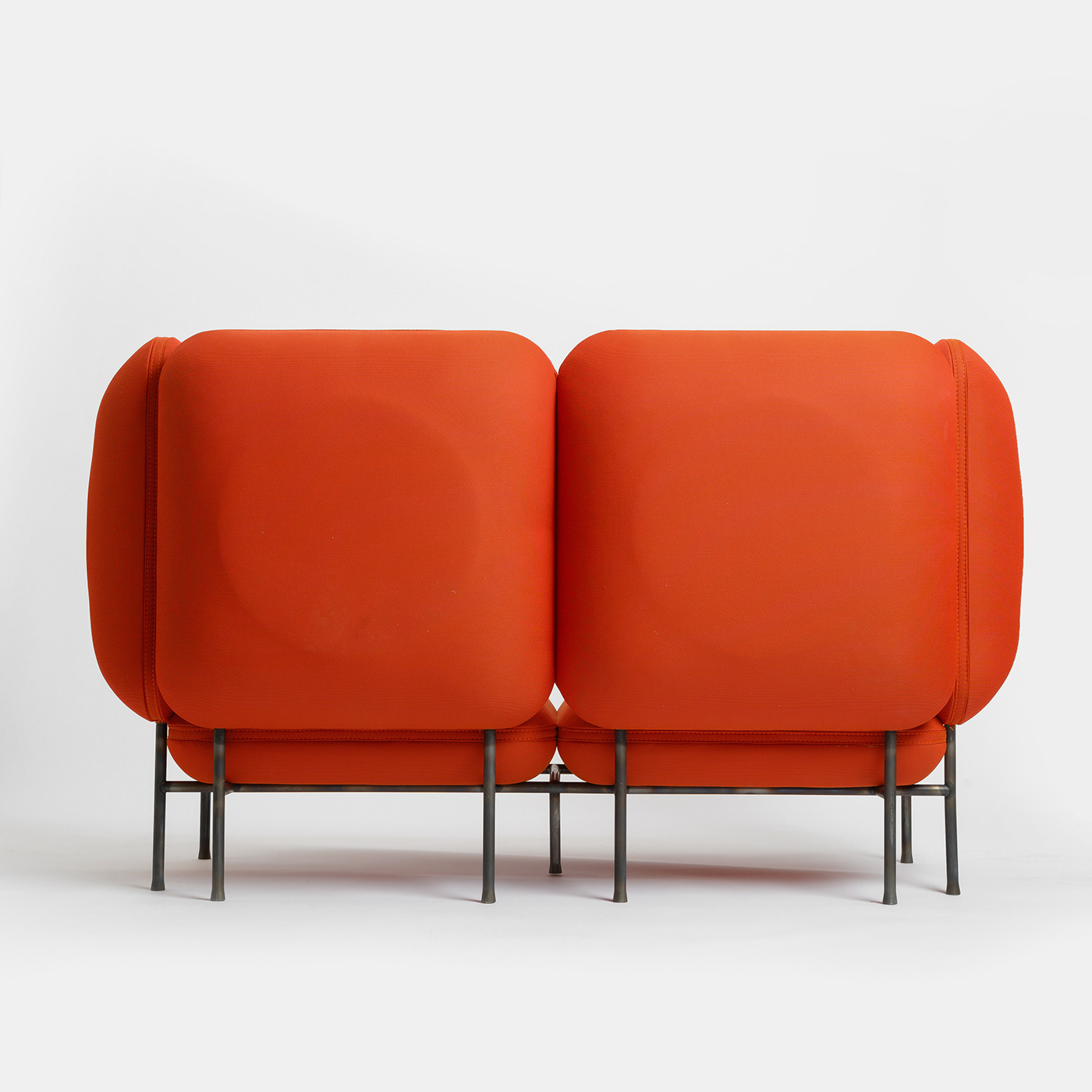
Photo: Milán Rácmolnár







Photo: Milán Rácmolnár
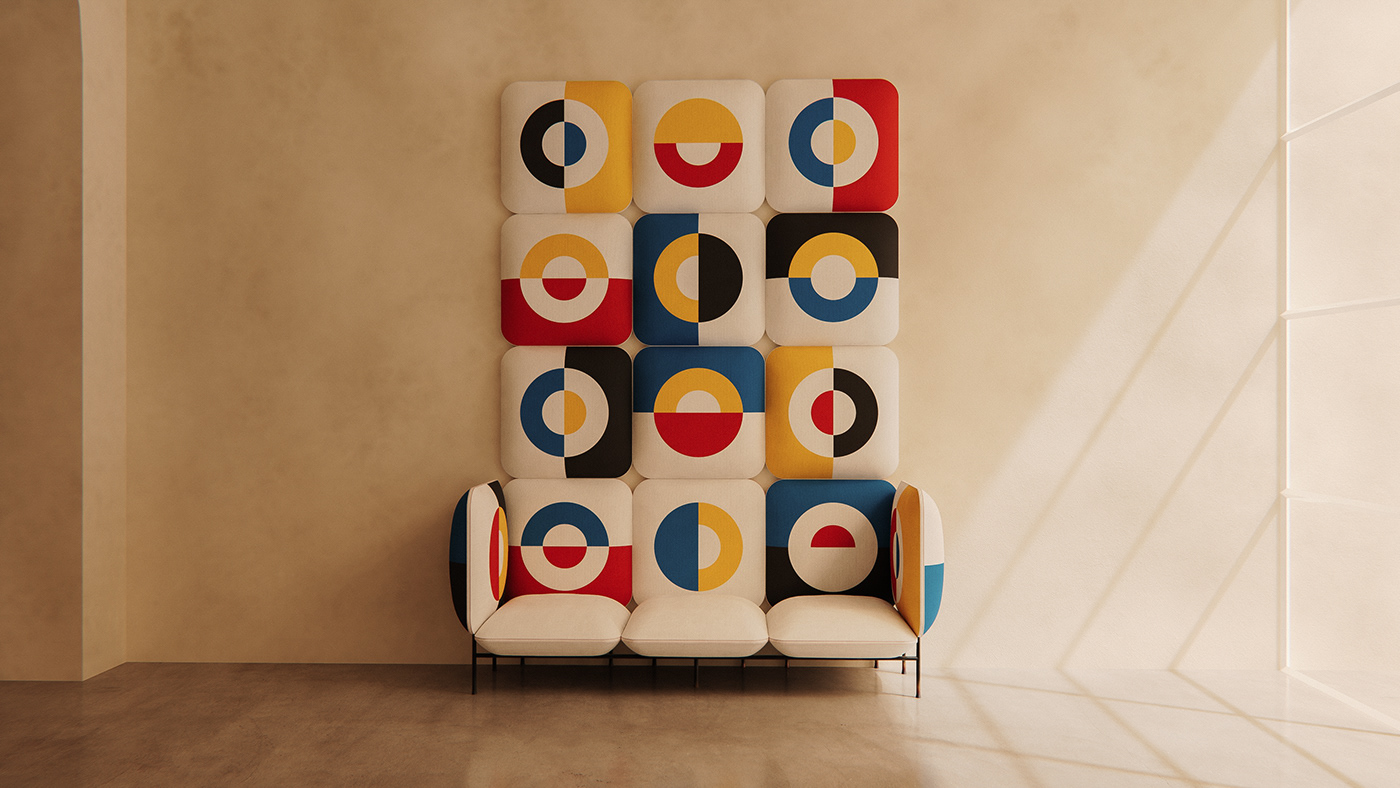
Render: own
ROLY-POLY
lighting system
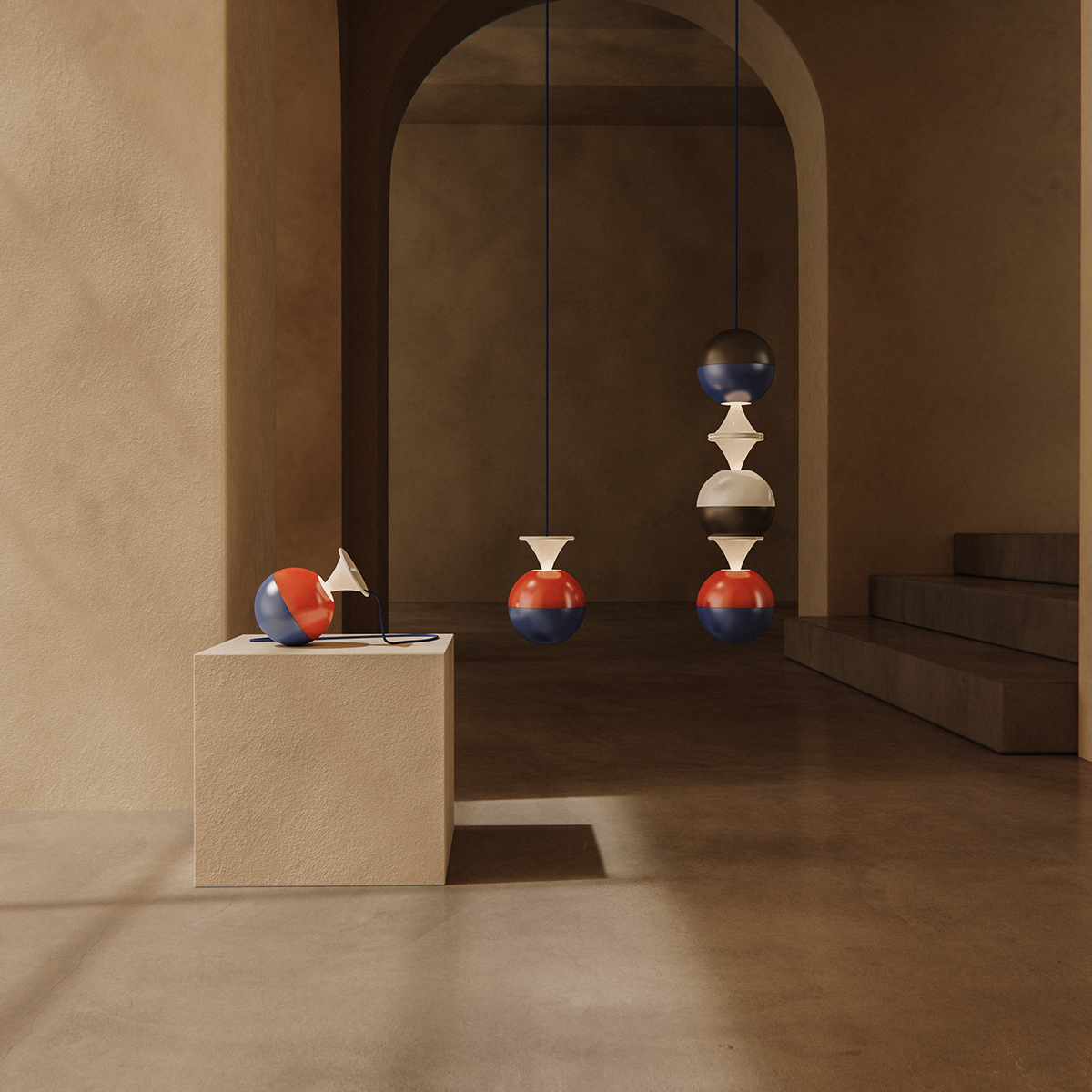
Render: Own

Photo: Artúr Ekler

Antecendens
This family of enamelled lamps has a connection to another group of works born in the former “Architectural Enamel Art Camp" in Bonyhád.
Although the creators there deliberately avoided using the word “sculpture”, they still created spatial elements and "outdoor statues", which expanded the scope of flat-panel experimental works with their sculptural structure and elements evoking totem columns. Besides Ferenc Lantos, János Fajó and Gyula Pauer also incorporated ordinary objects to their works; ordinary pieces of socialist everyday life, such as the laver and the bucket. (Moreover, they used scrap metals destined to waste from the factory yard!)
Roly-Poly has risen from another ordinary everyday object, the popular, metal stamped roly-poly toy. It evokes the consolidating hungarian 70’s (the Kádár regime) and the Soviet-style previews of the rough and charming world of enamelled metal children’s toys at once. Besides this cultural sociological origin, the luminaire also creates parallels using the formal gestures and elementary geometry of the toy.





Photo: Anett Pósalaki


Photo: Artúr Ekler

INSPIRATIONS
The standing table lamp version of the family is also the eponymous main piece, the name Roly-poly suggests.
Here, the roly-poly form is also paired with a matching mode of operation: the weight hidden in the sphere tilts the lamp out of the vertical axis, on the other hand, with the help of this weight, the user can also operate and wave the lamp. The outer mantle of the head-evoking funnel receives the scouring light from inside the sphere thus making the lamp indirectly bright, especially suitable as mood lighting. Uninterrupted wobbling is also supported by the fact that the power cord is not connected to the lamp from below, from the sphere, but through the funnel.
The “ceiling-hung” lamps of the “Roly-poly” family evoke and further enliven the former “outdoor statues” from Bonyhád. While 1 or 2 luminaires stacked on top of each other can be seen as traditional or customary, by increasing the number of elements, the overall appearance can become more and more sculptural. The fastening system behind this idea even makes it possible that the stringing of pendants might reach the floor. As the individual lamp elements still provide indirect light, the multi-element, strung “totem poles” also result in an increasingly accentuated and spectacular play of light, enhancing the plasticity and symbolism of the object.
The light sources of the lamps are warm-white colour temperature LED modules. Their brightness can be adjusted, which – as a mood lighting – can be an important user expectation. According to the plans, while in the standing version, the light deflection funnel is scheduled to perform the switching itself, the suspended versions will be operable with a wall control switch. The visible cable sections are wires covered with textile weaving.

Photo: own

Photo: own
TECHNICAL DETAILS
Like all pieces of Burnt Geometry, the lamp family was made by Hungarian implementers and manufacturers. The use of local infrastructure was an important consideration in the definition of both technologies and materials.
The components of the luminaires are made of sheet metal with metal spinning, and their colouring follows rather strict principles: the two hemispheres are always different colours, the funnel is always white, but the colour palette used is narrow, currently only available in different combinations of red, blue, white and black.
The enamel factory in Bonyhád, which has been mentioned above many times as a preview, still operates today, mainly producing traditional enamelled dishes and boards. Enamelling the lamp family might not be a new area for the workers/professionals of Bonyhád, but it may open up new gates in the long run, further helping their marketable operation.
The structural development, the optimization of series production and the assembly are provided by LumoConcept.
The design of the “Roly-poly” lamp family also fits into the scheme that is characteristic of the entire “BurntGeometry” collection – which is the strongest possible representation and commitment to the sustainability criteria. In the case of lamps these involve the use of metal and the operation of LED technology as a lower energy lighting method. Fire enamelling is a recyclable surface treatment process, making it an ideal solution to replace the more common plastic-based powder coating. With the “Roly-poly” enamelled lamp family, we have taken the first step in rediscovering this technology. In the future, we will examine the new possibilities and sustainable aspects of enamelling which also allows for greater variety in the surface treatment of the lamp.



Photo: Artúr Ekler - The enamel factory in Bonyhád 2022

Photo: Artúr Ekler - The enamel factory in Bonyhád 2022



Photo: Artúr Ekler - The enamel factory in Bonyhád 2022


Photo: own

Photo: own

Photo: Artúr Ekler

VANISHING CABINET
cabinet

Render: own
INSPIRATIONS
One of the most striking members of the “Burnt Geometry” collection is the “Vanishing Cabinet” family of cabinet furniture. The pattern of the door fronts, created from elementary geometric forms, yet becoming organic, is directly related to the research of Ferenc Lantos, who sought the feasibility of this in his partly theoretical and partly practising works of art. His most significant enamel works on this subject, the Tulips set up by Tettye Hill in Pécs, which he apostrophed as experiments on space, can also be seen as a source of inspiration.
Lantos' Tulips are not without precedent in post-war art: Bartók's genius, which created one of the most modern and eternal types of music by transposing (Hungarian) folk art, encouraged many artists to find inspiration in the visual folk tradition. The oeuvre of Lajos Vajda, (from Szentendre mainly) Dezső Korniss, then Victor Vasarely from Pécs, later, following his steps Ferenc Lantos or Ilona Keserü, and later István Nádler and Imre Bak turned to the memories of folk decorative tradition.
Two phenomena from this high artistic heritage can be seen on the geometric front panels of the “Vanishing Cabinet”. One cites Dezső Korniss's “szűr” (a traditional hungarian piece of clothing) motifs, which are considered to be iconic features of his III. creative era. One way to decorate the “szűr” is to use overlaid (sewn) floral motifs. The linoleum layering used in the cabinet can also be interpreted as an analogy to this applique decorative tradition. The other one is an oil painting made by Ilona Keserü in 1969, the Suszék Study II (Edited Wave). The circular geometric motifs of the oil painting and the use of colour indicate a commonality between the two creators, the artist and the designer, with similar results.



Photo: Anett Pósalaki

Photo: own
Description
The basic organising unit of the decorative front surface is the square, which is divided by patterns edited from quarter circles. At the same time, both the squares and the quarters or semicircles are planes built in front of each other, thus the pattern becomes three-dimensional and a function of use appears from the layers, as this also forms the handle of the doors of the cabinet body.
The foot structure of the cabinet is very similar to the one used for DEDAS seating furniture, both in terms of sizing and material use or surface treatment. The goal is the same: to associate furniture with fire enamel origins by direct association. Moreover, in the case of the Vanishing Cabinet, this “fiery” bond is accentuated in another way: the back panel of the cabinet is an inside-out patinated, iridescent sheet metal. This gesture is also parallel to Dedas, as the back equivalent to the front allows the cabinet to be put in space, similar to upholstered furniture.
The Vanishing Cabinet also refers to an editorial principle, a front-training method. The prototype presents one possibility, but in the near future we would like to develop this principle in order to satisfy the demand for cabinet furniture with different functions with the richest possible product range.

Photo: own





Photo: own
TECHNICAL DETAILS
Like all pieces of Burnt Geometry, the cabinet family was made by Hungarian implementers and manufacturers. The use of local infrastructure was an important consideration in the definition of both technologies and materials. The structure has been designed so that in the future we can even manufacture it in our own workshop.
The use of selected materials of exclusively natural origin in this furniture is, if not completely new, definitely innovative. The cabinet body and fronts consist of blocks glued from coloured MDF boards, the body is typically anthracite-black and the fronts are in different colours. Finally, a closing plane made from coloured linoleum sheets is also placed on the doors. The surface treatment of wood panels pressed from spruce chips and pigments is done with natural oils.
Linoleum is a natural surface-forming material pressed from linseed oil, pine resin, limestone and cork.
The use of metal elements with the firing surface treatment and the waxed surface seal to be applied meets the above explained sustainability criteria of other families in the collection.

Photo: own
DAD'S FENCE
room divider

Render: own
INSPIRATIONS
The world of the “Dad’s fence” indoor screen family is a cultural reference to rural Hungary in the ’70s.
One of the connecting links is the aesthetics of lack and its objectified forms, a certain kind of iron fencing. At that time, around every Hungarian city where there was a factory engaged in some kind of metal processing, mainly metal stamping, extrusion, or punching, an unusual type of fences began to appear, which were made of special, uniquely patterned steel plate strips. This raw material entered the framework of modern “folk art” through the circulatory channels so characteristic of socialism (meaning stolen from the factory). In fact, it was the surplus that meant the material relationship between the essential, extruded parts. The subjects of the repetitive samples were not important – it was impossible to recognize in retrospect what parts were actually extruded by the machines.
The aesthetics of the lack is thus, in fact, twofold: it indicates the varied, unique set of patterns formed by the holes, gaps and openings left behind by the lost workpieces, and refers to the ordinary experience of functioning socialism, the lack of things. Another element of cultural identity is “folk art” rooting. Evoked in connection with the “Vanishing Cabinet”, Ilona Keserü discovered another type of fence in the mid-1980s, the cast concrete panel delimiters of the more wealthy rural areas, but we see the same mentality behind the two uses: they still preserve the object-oriented and decorative motives of peasant existence but the tinkering is already showing up. Keserü writes: “...folklore… is a constant present integrative relationship that“ recharges ”itself in any… socio-cultural situation”. “Dad’s Fence” is a different kind of design-driven, yet full value reloading of the original phenomenon.




Photo: Dare studio
DESCRIPTION
In this collection, besides the simple and clear structural and editorial principles, there is always a large amount of unpredictability thanks to the randomness of the scrap metal that fills the framed fields.
Even if the frames, the basic dimensions and the surface treatment techniques are given, but the most important details, the patterns of the filling fields are completely random and inevitable. They depend on the type of waste materials currently used. Although the role of pressing and punching machines in today’s metalworking industry has been mostly taken over by laser cutting equipment, this does not change the end result drastically. The task of the designer in this case was rather to design the system of relations, the rule, where the meeting of the variables and the invariable had to be reconciled.
The variable is the material pattern and dimension of the waste, and the invariable is the set of expectations resulting from the structure of the frame and the function of the furniture. The simple construction, which was easy to build and fit the rest of Burnt Geometry was an important aspect. Thus, it was obvious to evoke the supporting “spikes” used in enamelling through the use of expanded steel tubes and patinated surfaces. This furniture is all about emphasising the system of relationships, the visual rhythm.

Render: own

Photo: own

Photo: own

Photo: own
TECHNICAL DETAILS
Like all pieces of Burnt Geometry, the screen was made by Hungarian implementers and manufacturers. The use of local infrastructure was an important consideration in the definition of both technologies and materials.
Today, this type of material use – production from the end product and waste of another production process – can be called very modern. However, Dad’s Fence also draws our attention to another phenomenon – the creativity of poverty. Poverty is often no good for sustainability. Deficiency and deprivation destroying the quality of life, makes it difficult or even impossible to differentiate between sustainable and environmentally harmful methods, be it food, fuel, anything. However, an attitude that considers the full use of things to be natural is one of the most progressive ideas. It is a base that any designer can build on.





Photo: own

Render: own
Product and furniture design: Annabella Hevesi
Project management: Gábor Bella, Annabella Hevesi
Photography: Artúr Ekler, Anett Pósalaki, Milán Rácmolnár, Dare studio, Annabella Hevesi
Renders: Annabella Hevesi
Special thanks to:
Edit Lukács, Fanni Czegle, Gergely Tasnádi, Benedek Bella, acb Gallery, Kálmán Debreceni, Zoltán Merényi, Kárpitos Partner Group Bt., LumoConcept, Ema-lion enamel factory, BER-TIB Bt., PONTEX Kft., Hungarian Fashion & Design Agency, JAB Anstoetz KG, Nuans Textil, Dare studio
2022
by IO





